 |
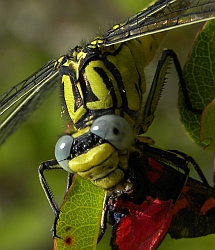 Female Yellow Clubtail Female Yellow Clubtail
Gomphus simillimus© Teresa Farino
Natural History of the Picos de Europa and Páramos of Northern Castile
Discover the fabulous mid-summer diversity of birds, butterflies & moths, dragonflies and wildflowers of northern Spain
The jagged limestone mountains of the Picos de Europa are one of those rare places in Europe today that still combine magnificent scenery, a thriving rural economy and a rich flora and fauna. Our visit is timed to enable us to observe many of the more emblematic mammals, birds, reptiles and amphibians, butterflies and moths, dragonflies and wildflowers that thrive here, and will be complemented by the very different community of animals and plants that inhabits the limestone plateaux further south.
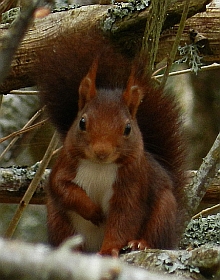 Red Squirrel Sciurus vulgaris© Teresa Farino Red Squirrel Sciurus vulgaris© Teresa FarinoDuring the first part of the tour (5 nights) we will be based at El Hoyal, a friendly family-run hotel in Pesaguero, just 50 metres from Teresa's home, where we can run the moth trap and congregate for pre-dinner drinks and discussion of the day's findings. From this base, we will explore the forests, haymeadows and subalpine habitats of the valley of Liébana, on the southeastern flank of the Picos de Europa. Our second base will be the converted convent of Santa María de Mave, complete with its own Romanesque church, ensconced amid the páramos of northern Castile. We shall spend four nights discovering the delights of these limestone plateaux, as well as the neighbouring river valleys, heathlands and forests.
In terms of the mammals we might see in the Picos de Europa, the Southern Chamois of the high peaks takes pride of place, with Wild Cat, Red and Roe Deer and Red Squirrel also very possible. Our hotel in Pesaguero lies within the Brown Bear Protection Area, and although we are unlikely to encounter one of these rather scarce creatures, signs of their passage are
 Red-backed Shrike
Red-backed Shrike
Lanius collurio
© Teresa Farino
commonplace around the village. We can also make a series of evening forays from both hotels, armed with bat detectors, in order to track down some of the score or so species of bats that occur in northern Spain.
Bird-wise, in the subalpine habitats of the Picos we should encounter Water Pipit, Alpine Accentor, Red-billed and Alpine Choughs, Snow Finch and, with luck, Wallcreeper, while the forests are home to Black and Middle Spotted Woodpeckers, Crested Tit, Firecrest, Bonelli's Warbler, Citril Finch and Crossbill. Griffon and Egyptian Vultures cruise the skies in search of carrion, and we should also be able to observe a good range of other raptors, including Golden, Short-toed and Booted Eagles, Black Kites, Honey Buzzard and Peregrine. Teresa has also spotted Lammergeiers here on several occasions in recent years.
Other notable Picos birds include Alpine Swift, Wryneck, Woodlark, Crag Martin, Dipper, Blue Rock Thrush, Whitethroat, Marsh Tit, Short-toed Treecreeper, Red-backed Shrike and Cirl and Rock Buntings. Once in the Castilian plains, White Storks abound, and we should also be able to track down Montagu's Harrier, Red Kite, Bee-eater, Hoopoe, Yellow Wagtail, Nightingale, Rock Thrush, Melodious Warbler, Golden Oriole, Southern Grey Shrike, Spotless Starling, Rock Sparrow and Corn Bunting.
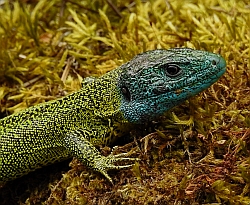 Schreiber's Green Lizard
Schreiber's Green Lizard
Lacerta schreiberi
© Teresa Farino
Many species of reptiles and amphibians occur in the Picos de Europa, and we should encounter such charismatic creatures as Ocellated and Schreiber's Green Lizards, Large Psammodromus, Iberian Three-toed Skink, Slow-worm and Seoane's Viper, with the Castilian páramos adding Western Green Lizard, Smooth Snake and Lataste's Viper to our list. Among the amphibians, we usually manage to locate Alpine, Palmate and Marbled Newts and Common Midwife Toad in the Picos, with Iberian Water and Iberian Tree Frogs more likely along the rivers of the Castilian plains.
In mid summer, both locations will provide us with an enormous diversity of butterflies, and we can expect to see 50 or more species per day, weather permitting. The Picos de Europa is home to such memorable creatures as Large Chequered and Marbled Skippers, Apollo, Bog Fritillary, Chapman's Ringlet (endemic to northern Spain), Purple-edged Copper and Spanish Purple Hairstreak, among a host of others. By way of contrast, our daily excursions in the páramos should enable us to observe a number of butterflies that
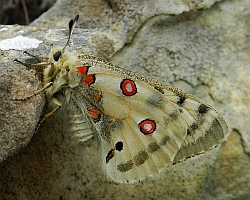 Apollo Parnassius apollo
© Teresa Farino
are not found in the Picos de Europa proper, including Meleager’s, Amanda's and Forster’s Furry Blues and Twin-spot Fritillary, as well as an abundance of species that are rather rare further north, such as Safflower Skipper, Southern White Admiral, Niobe Fritillary, Cardinal, Spanish Gatekeeper, Chestnut Heath and Sloe Hairstreak.
Apollo Parnassius apollo
© Teresa Farino
are not found in the Picos de Europa proper, including Meleager’s, Amanda's and Forster’s Furry Blues and Twin-spot Fritillary, as well as an abundance of species that are rather rare further north, such as Safflower Skipper, Southern White Admiral, Niobe Fritillary, Cardinal, Spanish Gatekeeper, Chestnut Heath and Sloe Hairstreak.
We shall set up the moth trap in both localities every evening, and will spend an hour or so before breakfast examining the contents. On warm, moonless nights, the trap attracts large numbers of both species and individuals; there are over 820 species of macromoth on Teresa's Picos list, including 14 hawkmoths, many species that are endangered in the UK, and several Spanish endemics, notably Spanish Tiger (Hyphoraia dejeani). A quite different range of species is expected at our hotel in Mave, including the stunning Purple Tiger, Ground Lackey, Eyed Hawkmoth and Alpine Prominent. 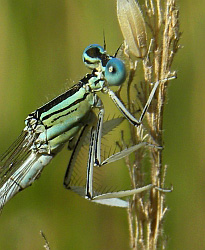 Male White Featherleg
Male White Featherleg
Platycnemis latipes
© Teresa Farino
Day-flying moths will also be recorded, and we shall be looking out for Hornet and Fiery Clearwings, Narrow-bordered and Broad-bordered Bee Hawkmoths, Scarlet and Wood Tigers and a host of eye-catching burnet moths, particularly White-collared (Broom), Mediterranean, Chalk, Merry and Algarve.
In wetland habitats we shall also be looking out for dragonflies and damselflies, with Beautiful Demoiselle, Common Bluet, Large Red Damsel, Emperor, Common Goldenring, Red-veined Darter and Broad-bodied Chaser typical of the Picos at this time of year, while a careful exploration of the riverine habitats and marshy areas of the Castilian plains should enable us to add Western Demoiselle, Mercury Bluet, Iberian Bluetail, several species of Spreadwings, White Featherleg, Yellow Clubtail and Yellow-winged Darter to our list.
Floristically, one of the highlights is undoubtedly the glorious swathes of colour in the higher haymeadows of the Picos de Europa, teeming with Maiden Pink, Musk Mallow, Horned and Violet Mountain Pansies,
 Woodland Brown Lopinga achine
© Teresa FarinoSticky Flax, Bloody and Wood Crane's-bills, Great Yellow Gentians, Viper's-bugloss, Large Self-heal, Whorled Lousewort, Greater Yellow Rattle, Spreading and Rampion Bellflowers, White Asphodels, White False Helleborine and English Iris. Some of the orchids still in flower at this time of year might include Dark Red Helleborine, Bird's-nest, Early Marsh, Frog, Lizard and Fragrant Orchids, Heart-flowered Serapias, Bee Orchid and the Iberian endemic vanilla orchid Nigritella gabasiana.
Woodland Brown Lopinga achine
© Teresa FarinoSticky Flax, Bloody and Wood Crane's-bills, Great Yellow Gentians, Viper's-bugloss, Large Self-heal, Whorled Lousewort, Greater Yellow Rattle, Spreading and Rampion Bellflowers, White Asphodels, White False Helleborine and English Iris. Some of the orchids still in flower at this time of year might include Dark Red Helleborine, Bird's-nest, Early Marsh, Frog, Lizard and Fragrant Orchids, Heart-flowered Serapias, Bee Orchid and the Iberian endemic vanilla orchid Nigritella gabasiana.
An examination of the subalpine limestone rock gardens of the Picos de Europa should reward us with, the Picos endemic columbine Aquilegia pyrenaica ssp. discolor, Pink Sandwort, Dark Stonecrop, Saxifraga canaliculata, Alpine Rose, Pyrenean Vetch, the endemic greenweed Genista legionensis, Pyrenean Eryngo, Trumpet Gentians, Pyrenean Germander,  Blue Cupidone Catananche caerulea
© Teresa Farino Alpine Toadflax, Fairy Foxglove, Globularia nudicaulis and Alpine Aster, with Astrantia, Spiked Rampion, Pyrenean Valerian, Spiked Star-of-Bethlehem, Pyrenean and Martagon Lilies and Herb-Paris adorning the woodland habitats.
Blue Cupidone Catananche caerulea
© Teresa Farino Alpine Toadflax, Fairy Foxglove, Globularia nudicaulis and Alpine Aster, with Astrantia, Spiked Rampion, Pyrenean Valerian, Spiked Star-of-Bethlehem, Pyrenean and Martagon Lilies and Herb-Paris adorning the woodland habitats.
Once we arrive on the páramos of northern Castile, the flora will be supplemented by eye-catching species such as Coris, Pistorinia hispanica, Saxifraga cuneata, Montpellier Milk-vetch, Beautiful Flax, Silvery-leaved Pink Convolvulus, Meadow Clary, Spanish Bellflower, Blue Cupidone, St Bernard's Lily, Blue Aphyllanthes, Wild Gladiolus and Bug and Pyramidal Orchids.
NB For the duration of the tour, you will be covered by Teresa's permits both to catch butterflies and trap moths (a legal requirement for Spain). All the lepidoptera records we collect will be submitted to the Cantabrian and Castilla y León regional governments and the Picos de Europa National Park authorities, under the auspices of a project initiated by Teresa in 1989.
"Thank you for a wonderful time in the Picos and Páramos. It was amazing trip. You took us to terrific locations, each with its own character. Each day I thought you couldn’t possibly outdo the sights you’d shown us the previous day, but you did! Seeing the wonderful diversity of butterfly species and the numbers of butterflies on your wildlife trip was like visiting the Garden of Eden. It was just glorious. Everywhere we looked there seemed to be flowers and butterflies. I particularly enjoyed walking along the quiet country roads and tracks looking at the flowers and stalking the butterflies to take photos. It was great fun. // That was a remarkable trip. Thank you very much for giving your all and making it a delight for me/ us. The places were varied, and for a novice like me, the butterflies and moths (the larger ones!) were fascinating, not to mention the plants and landscape. Your knowledge is remarkable and you were very patient with my endless (and repetitive) questions." Sue S. // Diana K July 2017
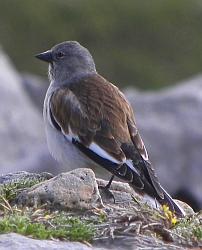 Snowfinch Montifringilla nivalis
© Teresa Farino
Snowfinch Montifringilla nivalis
© Teresa Farino
Natural History of the Picos de Europa & Páramos of Northern Castile
Leaders: Teresa Farino
2018 Dates: Tues. 3 July – Thurs. 12 July (10 days / 9 nights)
Price: 1,790€ per person, including half-board, en suite accommodation at Posada El Hoyal and El Convento, picnic lunches, minibus/4WD transport throughout, all entry fees and the services of the leaders. A single-room supplement of 250€ is applicable.
Although the cost of the tour is given in euros, clients may pay in sterling, the exchange rate to be calculated at the time of payment using www.oanda.com.
This is a land-based tour. Flights and travel insurance (obligatory) are the responsibility of the client.
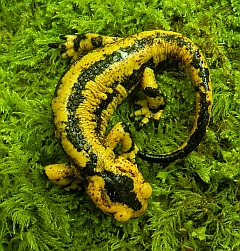 Fire Salamander Salamandra salamandra
© Teresa Farino
Fire Salamander Salamandra salamandra
© Teresa Farino
Pick-up details: For this tour, clients will be booking their flights independently. Teresa will be meeting the British Airways flight from London Heathrow to Bilbao, which gives us by far the most convenient flight times for these dates as well as giving us almost eight full days in the field. Details are as follows:
2 August (BA0466)
Departs London Heathrow at 08.35
Arrives Bilbao at 11.30
9 August (BA0469)
Departs Bilbao at 19.40
Arrives London Heathrow at 20.30
Alternatively, those travelling to northern Spain independently can arrange to meet the group at El Hoyal on the first evening.
Group size: maximum 8 clients.
Booking information: please contact Teresa Farino for further details and a booking form, or if you have any queries about these tours.
| E-mail: |
|
|
| Office phone: | (+34) 942 735154 |
| Mobile phone: | (+34) 656 337129 |
|
| Address: |
Apartado de Correos 59
39570 Potes
Cantabria
Spain
|
|